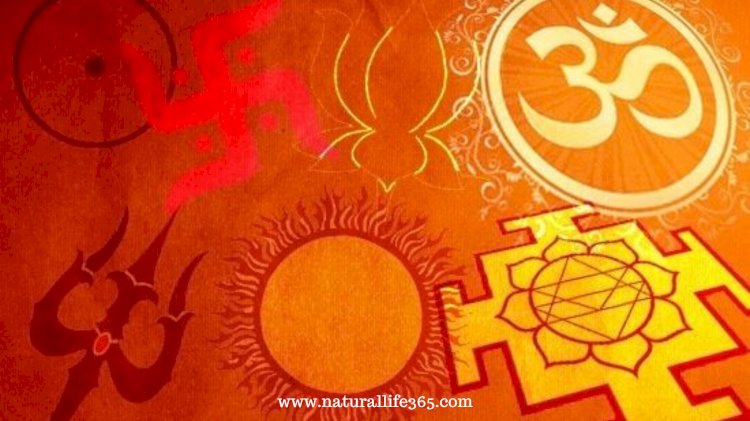What are The Most Important Symbols in Hinduism?
Hinduism is a religion rich in symbolism, with each symbol carrying its own significance and meaning. In this post, we explore the most important symbols in Hinduism, including the lotus flower, and the swastika, among others.

As mentioned in many posts here, Hinduism is one of the world's oldest and most complex religions. With over a billion followers, it is also one of the most widely practiced religions. One of the unique features of Hinduism is the use of symbols. Symbols play a crucial role in Hinduism, and they are used in various forms such as art, literature, and rituals. Each symbol has a unique meaning and significance that represents different aspects of Hinduism.
In this article, we will explore the most important symbols in Hinduism. We will discuss their meaning, significance, and how they are used in Hinduism. These symbols have been an integral part of Hinduism for centuries and continue to be relevant to this day.
By learning about these symbols, we can gain a deeper understanding of Hinduism and its rich cultural heritage. The symbols represent the beliefs, values, and traditions of the Hindu religion, and they serve as a way to connect with the divine. Whether you are a follower of Hinduism or simply interested in learning more about this ancient religion, this article will provide you with valuable insights into the most important symbols in Hinduism.
You can also read Tagore and the Bengali Renaissance: An Exploration of His Influence on Indian Culture and Beyond
Om/Aum
Om or Aum is one of the most important symbols in Hinduism, and it is considered to be the most sacred sound in the universe. It is often chanted at the beginning and end of Hindu prayers and is considered to be a powerful mantra that helps to focus the mind and connect with the divine.
The symbol for Om is made up of three Sanskrit letters, A, U, and M, which represent the three aspects of the universe: creation, preservation, and destruction. The sound of Om is said to contain the essence of the entire universe, and it is believed to be the sound of the universe itself.
In Hinduism, Om is used in a variety of ways. It is chanted during meditation and yoga practices to help calm the mind and focus on the divine. It is also used in rituals, such as the puja, where it is chanted to invoke the blessings of the deities.
The symbol for Om is often depicted in Hindu art, such as on statues or paintings, and it is also used in jewelry and clothing. It is a symbol that represents the spiritual essence of Hinduism, and it is widely recognized as a symbol of peace, harmony, and spirituality.
In popular culture, Om/Aum has gained recognition beyond the Hindu religion. It has been featured in movies and music, and it is often used as a symbol for yoga and meditation practices.
In conclusion, Om/Aum is an essential symbol in Hinduism that represents the spiritual essence of the religion. It is a powerful mantra that is used in meditation and yoga practices, and it is also used in rituals to connect with the divine. The Om symbol is widely recognized as a symbol of peace, harmony, and spirituality, and it continues to be an important symbol in Hinduism and beyond.
If you are looking for a beautiful Om for decorating your prayer room or maybe a living room, this wall sticker can be a great option for you. The dimensions of this wall sticker are 40 x 50 Centimeters. It is waterproof so you can also clean it with a wet cloth.
Rangoli Large Modern Art Wall Sticker Multicolor Vinyl Sticker
Swastika
The swastika is one of the oldest and most widely used symbols in the world. It is a symbol of good fortune and prosperity, and it is considered to be one of the most important symbols in Hinduism. However, the swastika has also been associated with negative connotations due to its use by Nazi Germany during World War II.
In Hinduism, the swastika represents the sun, and it is a symbol of the cycle of birth, death, and rebirth. It is often used in Hindu rituals, such as weddings and other ceremonies, to bring good luck and blessings. The swastika is also used in Hindu art, such as on statues or paintings, and it is commonly used in decorations for festivals and celebrations.
You may want to read Swastika: What Does It Mean For Hinduism?
Despite its significance in Hinduism, the swastika has become a controversial symbol due to its association with the Nazi party. The swastika was used by the Nazi party as their emblem, and it is now recognized as a symbol of hate and intolerance in many parts of the world.
However, in Hinduism, the swastika has always been a symbol of positivity, and it continues to be an important symbol for Hindus around the world.
In short, the swastika is one of the most important symbols in Hinduism. It is a symbol of good fortune and prosperity, and it is commonly used in Hindu rituals and celebrations. Although the swastika has become a controversial symbol due to its association with the Nazi party, it is important to remember that it has a long history that predates this association. For Hindus, the swastika remains a symbol of positivity and good luck.
During Diwali, we can decorate our homes with swastika symbols here and there, and that includes the front door. This metal craft golden brass hanging with 3 bells with the swastika symbol in the middle (15 x 7.5 x 3.5 Centimeters) is the perfect decoration your home needs or even, it is the perfect gift.
UAPAN Metal Craft Golden Brass Hanging 3 Bells Swastika Hanging Decor
Lotus
The lotus is another of the most important symbols in Hinduism, and it is considered to be a symbol of purity and enlightenment. The lotus is a water plant that grows in muddy water, but despite its surroundings, it remains pure and untouched by the impurities around it. This makes it a powerful symbol of spiritual awakening and enlightenment.
In Hinduism, the lotus is associated with many deities, including Lord Vishnu, Goddess Lakshmi, and Lord Brahma. It is often used in Hindu art and literature, and it is a common motif in Indian architecture. The lotus is also used in Hindu rituals and ceremonies, such as weddings and other celebrations.
The lotus is also important in yoga and meditation practices. The lotus pose, or Padmasana is a seated posture that is often used in meditation to help calm the mind and focus on the breath. The pose is named after the lotus because it is believed to represent the awakening of spiritual consciousness.
In addition to its spiritual significance, the lotus has also been used for medicinal purposes in traditional Ayurvedic medicine. The lotus plant is believed to have healing properties and is used to treat a variety of ailments, including digestive problems and respiratory issues.
If you have a Yoga saloon and would like to decorate it, this reiki crystal transparent lotus is a great option for positive energy, good luck, and prosperity. The dimensions of this crystal lotus are 65 mm x 100 mm and its weight is 275 grams approx.
Reiki Crystal Products Vastu/Feng Shui Transparent Crystal Lotus for Positive Energy
Shiva Lingam
The Shiva Lingam is one of the most important symbols in Hinduism, and it is a representation of Lord Shiva. The word "lingam" comes from the Sanskrit word "linga," which means "sign" or "symbol." The Shiva Lingam is a phallic-shaped stone or pillar that is worshipped as a representation of Lord Shiva's creative energy and power.
In Hindu mythology, Lord Shiva is the god of destruction and transformation, and he is often depicted with his consort, Goddess Parvati. The Shiva Lingam represents the union of Lord Shiva and Goddess Parvati and is worshipped as a symbol of their divine energy.
The Shiva Lingam is often found in Hindu temples, and it is worshipped by pouring water or milk over it and offering flowers and other offerings. The Lingam is also often adorned with the "Trishul," a three-pronged spear that represents Lord Shiva's power to destroy and transform.
The Shiva Lingam is also an important symbol in yoga and meditation practices. It is believed to be a powerful tool for spiritual awakening and is often used in meditation to help calm the mind and connect with the divine energy of Lord Shiva.
It is important to note that the Shiva Lingam is not meant to be worshipped as a phallic symbol. Rather, it is a symbol of Lord Shiva's creative energy and power, and it should be worshipped with reverence and respect.
In conclusion, the Shiva Lingam is often worshipped in Hindu temples and is used in yoga and meditation practices to connect with the divine energy of Lord Shiva. The Shiva Lingam serves as a reminder of the power of transformation and the importance of connecting with the divine energy within ourselves.
For those who are looking for a Shiva Lingam for their puja room, this beautiful one is a good option. This Shiva Lingam is made of marble in black color and its dimensions are 7.6L x 12.7W x 12.7H Centimeters.
StonKraft Black Marble Shiva Lingam Shiv Ling Mahadev Idol Murti Statue Moorti
Conch Shell
The Conch shell, also known as "Shankha" in Sanskrit, is also one of the most important symbols in Hinduism. It is a sacred object that is used in Hindu rituals and ceremonies, and it is believed to have spiritual and healing properties.
In Hindu mythology, the Conch shell is associated with Lord Vishnu, one of the principal deities of Hinduism. It is believed that the sound of the Conch shell is powerful enough to awaken the divine energy within us and can bring peace, harmony, and prosperity.
The Conch shell is also an important symbol in yoga and meditation practices. The sound of the Conch shell is often used in meditation to help calm the mind and promote relaxation.
In Hindu rituals and ceremonies, the Conch shell is often used to announce the beginning of a ceremony or to offer prayers to the deities. It is also believed to have purifying properties and is often used to sprinkle holy water during religious ceremonies.
The Conch shell is also used in traditional Ayurvedic medicine. It is believed that the sound of the Conch shell can stimulate the body's natural healing process and promote good health and well-being.
The Conch shell serves as a reminder of the power of sound and its ability to awaken the divine energy within us and this white conch shell for your puja room and ceremonies is for you. It has been hand carving with a floral design, it has around 400 grams and a dimension of 16 cm.
CENTORGANIC Conch Shell Blowing Shankh for Pooja Original (16 cm, White)
Tilak

Tilak is a sacred mark that is worn on the forehead by Hindus. It is a visible symbol of one's devotion to God and is often used to identify one's religious affiliation. The Tilak is made with a paste of sandalwood, turmeric, or other sacred materials and is applied in different shapes and colors depending on the sect and the occasion.
In Hindu mythology, the Tilak is believed to represent the third eye of Lord Shiva, which represents spiritual awakening and insight. It is also believed to be a reminder of the divine presence within us and serves as a symbol of protection and good fortune.
The Tilak is worn by both men and women and is an important part of Hindu religious and cultural practices. It is often applied during daily prayers, religious ceremonies, and festivals. It is also worn by Hindu priests and holy men as a sign of their spiritual authority.
The Tilak is not just a cosmetic accessory but has significant spiritual significance. It is believed to help the wearer focus their mind on the divine and promote inner peace and clarity. It is also believed to purify the mind, body, and soul and protect the wearer from negative energy.
The Tilak is an important part of Hindu religious and cultural practices and is a visible symbol of the rich spiritual heritage of Hinduism. This turmeric in a maroon color comes in a package of 50 gms and is very recommended for users because it is a 100% natural product and does not produce itching or irritate the skin.
Naachaas® Madurai Sri Meenakshi Amman Turmeric Special Thazhampoo Kumkum - Maroon Color - 500 gms
Trishula
The Trishula, also known as the trident, is a three-pronged spear that is an important symbol in Hinduism. It is most commonly associated with Lord Shiva, one of the principal deities of Hinduism, and is often depicted in his hand.
In Hindu mythology, the Trishula is believed to represent Lord Shiva's three aspects: creator, preserver, and destroyer. The three prongs of the Trishula symbolize the three gunas, or qualities of nature: sattva (purity and knowledge), rajas (passion and activity), and tamas (darkness and ignorance).
The Trishula is also believed to represent the three main nadis, or energy channels, in the human body: Ida, Pingala, and Sushumna. These channels are believed to regulate the flow of prana, or life force energy, throughout the body.
The Trishula is often used as a weapon in Hindu mythology and is believed to be a powerful tool for fighting evil and negative energy. It is also used as a symbol of protection and is often seen at the entrance of Hindu temples.
In addition to its spiritual significance, the Trishula is also an important cultural symbol in India. It is often used as a decorative element in art and architecture, and it is also used in traditional Indian martial arts.
In conclusion, the Trishula is a powerful tool for fighting evil and negative energy and is also used as a symbol of protection.
eCraftIndia Brass Trishul with Damru Decorative Handcrafted Figurine, Gold, One Size (BGO514)
Mala
A Mala, also known as Japamala, is a prayer bead necklace and is another important symbol in Hinduism. It is a string of beads used to keep count while reciting prayers or mantras. The Mala can be made of different materials such as rudraksha, tulsi, sandalwood, or other sacred materials.
In Hinduism, the Mala is believed to help the wearer focus their mind on the divine and promote inner peace and clarity. The repetitive recitation of prayers or mantras while using the Mala is believed to bring about a meditative state and help connect with the divine.
The number of beads on the Mala can vary depending on the sect and the deity being worshiped. The most common number of beads is 108, which is considered a sacred number in Hinduism. There are also Malas with 27 or 54 beads, which are used for shorter prayers or mantras.
The Mala is often used during daily prayers, religious ceremonies, and meditation practices. It is also used by Hindu priests and holy men as a sign of their spiritual authority. The Mala is an important part of Hindu religious and cultural practices and is a visible symbol of the rich spiritual heritage of Hinduism.
The Mala serves as a reminder of the importance of prayer, meditation, and spiritual connection in the Hindu faith.
In Hinduism, symbols play an important role in expressing and communicating religious and spiritual ideas. The symbols we have discussed in this article, including Om, Swastika, Lotus, Shiva Lingam, Conch shell, Tilak, Trishula, and Mala, are just a few examples of the many symbols that are significant in Hinduism.
Each symbol carries its own unique meaning and represents different aspects of the Hindu faith. For example, Om is a symbol of the ultimate reality and the sound of creation, while the Swastika is a symbol of auspiciousness and good fortune. The Lotus is a symbol of purity and spiritual enlightenment, while the Shiva Lingam is a symbol of Lord Shiva's creative energy.
The Conch shell is a symbol of the primordial sound of creation, while Tilaka is a symbol of devotion and spiritual identity. The Trishula is a symbol of Lord Shiva's three aspects and is a powerful tool for fighting evil and negative energy. The Mala is a symbol of prayer and meditation, and it helps the wearer focus their mind on the divine.
Overall, the symbols of Hinduism are a rich and meaningful way to connect with the divine and express one's faith. They serve as a reminder of the rich spiritual heritage of Hinduism and the importance of spiritual connection and devotion in the Hindu faith. Whether used in religious ceremonies, meditation practices, or as decorative elements (but always with respect), these symbols continue to inspire and enrich the lives of Hindus around the world.
You can also read Why is Ghee Important in Indian Culture?
If you value these free online resources provided by Natural Life 365, please consider supporting my website by sharing the blogs ![]()
DISCLAIMER:
Some of the links in this content may be affiliate links. This means that if you click on one of the links and make a purchase, I may receive a commission (at no extra charge to you). However, I only recommend products that I personally use and have tested myself. Also, understand that I have taken reasonable steps to ensure that the information on this content is accurate, but I cannot represent that the website(s) mentioned in this post are free from errors. Please, check the Affiliate Disclosure at the bottom of this website.







































